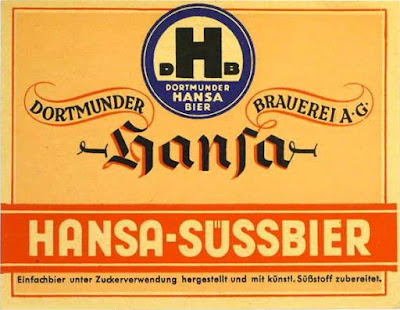Today's style, Süssbier, I believe is still brewed in small quantites. But the market for it is rapidly disappearing.
"SÜSSBIER.Couleur is a type of caramel. Even though this book was written just before the the Reinheitsgebot was extended all of Germany, these low-gravity top-fermenting beerswere allowed to uses all sorts of ingredients forbidden in bottom-fermenting beers.
Süssbiers are all coloured dark with Couleur or coloured malt and lightly hopped, as well as not very highly attenuated (up to 45%), to get a flavour like dark beer.
Süssbiers usually have an OG of 5-7% Balling; Beers of 10 - 13% Balling OG are rare and are usually called Weizenmalzbier, Hannoversch Broyhan, Werder’sches Bier, Hamburger Beer, etc.
Mashing procedure: it's mashed in at 30° R [37.5 C], rising after 25 minutes to 54° R [67.5º], when there's a saccharification rest, then it's heated to 60-61° R [75-76º C] and mashed out.
Usually, "high-dried" malt is used, and sugar is added (directly to the mash) up to 15 to 20% of the goods.
Through the addition of "Couleur" the beer acquires a mild taste.
Tun and barrel process. - The fermentation period is 2-3 days at a (pitching) temperature of 12-16 ° R. [15-20º C] as this yeast only ferments to a low degree of attenuation at this temperature. When fermentation is performed in a barrel, pitching is often at 15-18° R. [18.75-22.5º C] to cause the yeast be expelled better. - It is better not to go above 16° R, since all beers fermented over 16° R. (20° C) have a harsh flavour.
During the primary fermentation, the barrels are inclined at an angle and are stood up straight when expulsion of the yeast has ended.
Care must be taken to continually refill and keep the barrel completely full; and also to allow for a secondary fermentaion of 1-2 days but possibly as much as 8 to 10 days. It's important that there's a fiery break at the end of secondary fermentation, since otherwise bad malt has been used or an infection is present.
The beers are filled from the fermenting vessel into transport barrels and after a short carbonation period of 2-3 days they are served, or even into small transport barrels and subjected to a short secondary fermentation (with open bung) before they are finally sealed up. - Adding Kräusen is to be avoided, as it produces too strong a fermentation and can possibly cause the barrel to burst.
According to another method, "double beers" are transferred into storage barrels of 6, 8, 12, or even 16 hl of contents and left, with the bung open, to complete secondary fermentation and clarification.
At the end of the process, after 1-2 weeks, these beers are Kräusened and then filled into bottles or customer barrels."
"Die Fabrikation obergäriger Biere in Praxis und Theorie" by Braumeister Grenell", 1907, page 59 - 60. (My translation.)
I find it a bit odd that Broyhan is included in included in this class. It might have been partially-fermented and sweet, but I'm pretty sure it wasn't dark. It was a Weissbier, after all.












































































3 comments:
Yes, Ron, please go through all the styles, one by one. I am v interested in that sort of thing
I am particularly looking forward to your comments on the spontaneously fermented "Danziger Jopenbier", something I have never heard of. Although I do like a nice Jopen Koyt in Haarlem.
No relation, I guess.
Cheers!
Benj65
Real Malzbier with low abv (like Koch'sches Malzbier) or Doppelkaramell fall under that category, right?
Then I would say that this "style" is pretty much still alive, in some regions at least.
In the complicated history of world beers... Maybe dark mild was born in Germany and survived in the UK! :D
Maybe the whole caramel colouring is a German thing!
Post a Comment